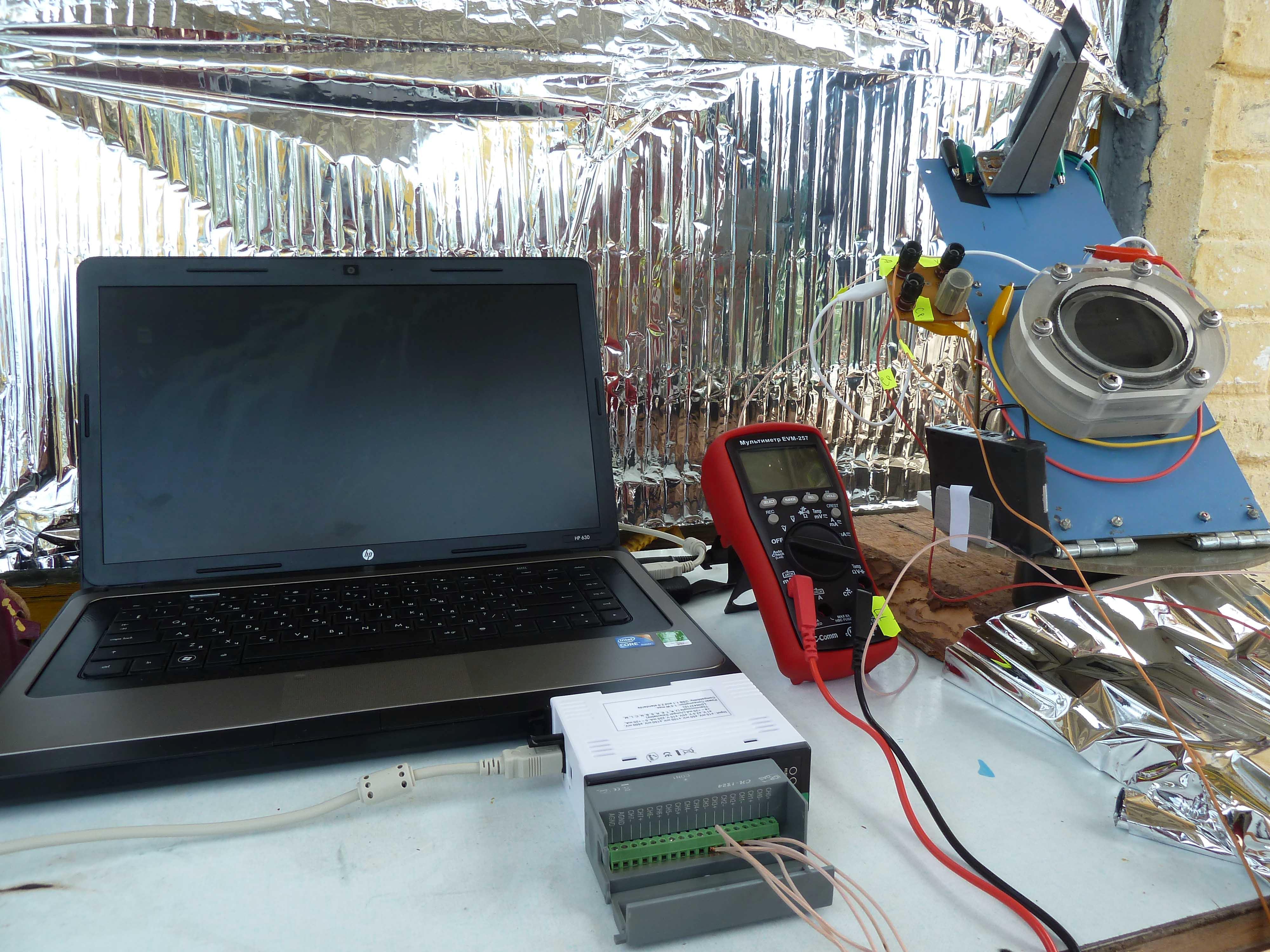|
|
Photoelectrochemical cell for accumulation of "solar" hydrogen

Experimental photoelectrochemical cell for hydrogen storage containing the sun tracking system: at clarification of the photoelectrochemical anode the hydrogen accumulates cathode. Reactions that occur at the electrodes in general form: cathode reaction:
M + H2O + e- = OH- + MH;
anodic reaction: 2S2- + 2p+ > S22-
|
Area of applications
It is supposed to use the photo electrochemical system for producing pure hydrogen as an energy source for power generation in the fuel cell, the hydrogen is oxidized by atmospheric oxygen as well as for chemical use. Reversible photoelectrochemical cell (photoaccumulator) can provide uninterrupted power supply of consumers under conditions of changing light intensity.
Brief description
Synthesis of electrochemical and chemical methods photosensitive electrodes based on polycrystalline films of semiconducting oxides, sulfides and selenides of metals (Ti, Zn, Zr, W, V, Sn, Cd, etc.). Which will contain graphene structure (oxide graphene and recovery oxide graphene) and modified nanoscale particles (quantum dots) of some semiconductors (ZnS, CdS, CdSe, etc.) will be investigated interfacial energy interface and photo-stimulated charge transfer mechanism to be determined photoelectrode and directions to achieve high efficiency of these systems fotoelektrohimchnyh cells with hydrogen storage As cathodes of photoelectrochemical cells are used MH alloys based intermetallic type AB5 and AB2 alloys with additions of magnesium. efficiency savings "solar" hydrogen cathodes will be investigated on the basis of graphene structures, modified metal or semiconductor nano-catalysts. Investigated and will be developed further reversible photoelectrochemical cell (photoaccumulator), in which the chemical energy is accumulated hydrogen is used to generate electricity.
Expected properties
Use as photoanodes materials that absorb visible light (for example, some compounds such AIIBVI and AIIIBV etc.), with the band gap of less than 2.7 eV modified surface, resulting in significantly increased value photopotential and reduced interfacial recombination and metal hydride cathodes, and cathodes based on graphene structures modified metal or semiconductor nano-catalysts with optimized kinetics of hydrogen sorption to the characteristics photoanodes, will more efficiently convert solar energy into chemical energy of hydrogen and makes it possible to build a photoelectrochemical cell and solar modules on the basis of efficient energy conversion of sunlight into chemical energy from hydrogen and cost efficiency sufficient for practical use. Studies and will be developed reversible photoelectrochemical cell (photoaccumulator) in which chemical energy is accumulated hydrogen is used to generate electricity, and which will ensure uninterrupted power supply of consumers under conditions of changing light intensity.
Advantages
Obtained in photoelectrochemical system hydrogen is very clear, it does not require further processing (purification) before further use. In addition, it is cheaper than the one obtained from the use of solid-state solar cell and electrolyzer because it does not require expensive and high-tech solar cells.
Competitors
MER (Material and Electrochemical Research) Corporation (US),
MV Systems, SRI International (Menlo Park, US),
Japanese New Energy and Industrial Technology Development Organization (NEDO),
Siemens (Germany), Hydrogenics (Canada),
BP plc, Praxair , Iwatani International (Japan).
Project development
The method of forming photosensitive nanoheterostructures type NT-TiO2 / CdSe-, NT-TiO2 / CdSexTe1-x- is the NT-TiO2 / CdxZn1-xSe and modifying their surface nanoparticles (quantum dots) of some metals and semiconductors was designed. The method of obtaining graphene structures (graphene oxide and graphene oxide recovery) was designed. There were full-scale tests of experimental photoelectrochemical cell for hydrogen storage.
Intellectual property
Patent of Ukraine №75975 "element of photoelectrochemical hydrogen accumulation" / Kolbasov GY, Solonin YM Rusetsky IA, Danko DB .; Applicants Institute of Problems of materials for materials University. IM Frantsevrycha Sciences of Ukraine, Institute of General and Inorganic Chemistry named. VI Vernadsky National Academy of Sciences of Ukraine; Bull. Number 6, issued 15.06.06.
Ukraine patent for utility model №73554 "element for photoelectrochemical hydrogen with Li leading membranoy" Slobodyanyuk IA, IA Rusetsky, Kolbasov GY, Kobylyanska SD, Belous AG .; applicant Institute of General and Inorganic Chemistry named. VI Vernadsky National Academy of Sciences of Ukraine; Bull. Number 18, published 25.09.2012.
Ukraine patent for utility model №78047 "oxygen electrode for current sources on the basis of reduced graphene oxide" Danilov MA, Slobodyanyuk IA, IA Rusetsky, Kolbasov H.YA .; applicant Institute of General and Inorganic Chemistry named. VI Vernadsky National Academy of Sciences of Ukraine; Bull. Number 5, issued 03/11/2013.
Contact information
Executing : Vernadsky Institute of General and Inorganic Chemistry NAS of Ukraine,
IM Frantsevich Institute for Problems of Materials Science of NAS of Ukraine
Project 7 «Photoelectrochemical cell for accumulation of" solar "hydrogen».
Project 15 «Development hydrogensorbing materials based on metal hydrides and their use as hydrogen batteries and electrodes for electrochemical energy systems direction».
Project leader:
 Kolbasov Henady Ya.
Kolbasov Henady Ya.
Project Manager №7
Tel. +38 044 424-22-80
Е-mail: kolbasov@ionc.kiev.ua
 Shcherbakova Larisa H.
Shcherbakova Larisa H.
Chief Executive project №15
Tel. +38 099 314-77-06.
Е-mail: larisa_c@ukr.net
|
|

 Kolbasov Henady Ya.
Kolbasov Henady Ya. Shcherbakova Larisa H.
Shcherbakova Larisa H.